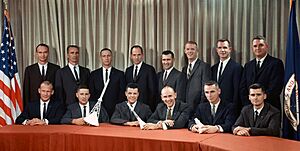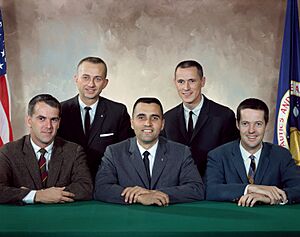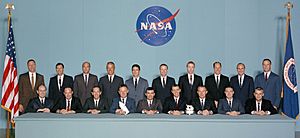List of Apollo astronauts facts for kids
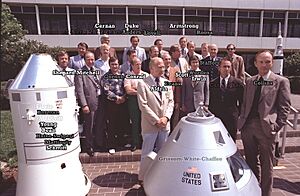
Between 1968 and 1972, 24 astronauts from NASA's Apollo program traveled to the Moon. Twelve of these brave explorers actually walked on the Moon's surface during six successful missions. Six of them even drove special vehicles called Lunar Roving Vehicles! Three astronauts visited the Moon twice, but only two of them landed. No human has ever traveled farther than these 24 men. While no woman has been to the Moon yet, some animals, like tortoises, turtles, and mice, have orbited it.
The Apollo missions 8 and 10 through 17 were the ones that carried people to the Moon. Other missions, like Apollo 4, 5, and 6, were uncrewed tests. The Apollo program also included three other crewed missions: Apollo 1 tragically ended with a fire during a ground test, and Apollo 7 and Apollo 9 stayed in Earth orbit to test the spacecraft. Some later Apollo missions (18, 19, and 20) were canceled. Many Apollo astronauts later flew on other space missions like Skylab and the Apollo–Soyuz Test Project.
Contents
Meeting the Apollo Astronauts
Donald K. "Deke" Slayton was in charge of choosing the crews for the Gemini and Apollo missions. He was one of the first American astronauts, but a heart problem kept him from flying for a while. Later, he was cleared to fly and even went to space on the 1975 Apollo–Soyuz Test Project mission.
The astronauts chosen for the actual missions were grouped by when NASA selected them. There were two main types of Apollo spacecraft: Block I for early tests and Block II for lunar landings. The crew roles also changed. For Block I, they were Command Pilot, Senior Pilot, and Pilot. For Block II, they were Commander, Command Module Pilot, and Lunar Module Pilot.
Astronauts Chosen by NASA
1959
- Virgil I. "Gus" Grissom was chosen for the first crewed Apollo mission, Apollo 1. Sadly, he and two other astronauts died in a fire during a test on the launch pad in January 1967.
- Walter M. Schirra Jr. commanded Apollo 7 in October 1968. This was the first crewed flight of the Apollo spacecraft, testing it in Earth orbit.
- Alan B. Shepard Jr. was the first American in space! He later commanded Apollo 14, which was the third successful mission to land on the Moon.
1962
Most of these astronauts flew on the Gemini missions before Apollo. Many of them commanded both a Gemini and an Apollo mission.
- Edward H. White II was the first American to walk in space during the Gemini program. He was chosen for Apollo 1 but died in the fire with Grissom and Chaffee.
- James A. McDivitt commanded Apollo 9 in March 1969. This mission tested the Apollo Lunar Module (the Moon lander) in Earth orbit.
- Frank F. Borman II commanded Apollo 8. This mission was the first time humans orbited the Moon in December 1968.
- James A. Lovell Jr. flew on Apollo 8 as the Command Module Pilot. He later commanded Apollo 13, which had a serious problem on the way to the Moon. He and his crew safely returned to Earth. Lovell is the only person to fly to the Moon twice without landing.
- Thomas P. Stafford commanded Apollo 10, which flew to the Moon and tested the Lunar Module in orbit, but did not land. He also commanded the Apollo–Soyuz Test Project mission.
- John W. Young flew on Apollo 10 as the Command Module Pilot. He later commanded the successful Apollo 16 lunar landing. He also commanded the very first Space Shuttle flight in 1981!
- Neil A. Armstrong commanded Apollo 11. He became the first human to step onto the Moon's surface.
- Charles "Pete" Conrad Jr. commanded Apollo 12, the second Moon landing. He later commanded Skylab 2, helping to fix the space station.
1963
This group was the first where astronauts didn't have to be test pilots. Military jet pilots were also accepted.
Five astronauts from this group flew on Gemini missions first:
- David R. Scott flew on Apollo 9 and commanded the Apollo 15 Moon landing.
- Eugene A. Cernan flew on Apollo 10 and commanded the very last Moon landing mission, Apollo 17.
- Michael Collins flew on Apollo 11 as the Command Module Pilot, orbiting the Moon while Armstrong and Aldrin landed.
- Edwin E. "Buzz" Aldrin Jr. flew on Apollo 11 and was the second person to walk on the Moon.
- Richard F. Gordon Jr. flew on Apollo 12 as the Command Module Pilot. He was supposed to command Apollo 18, but that mission was canceled.
The other six members of this group flew on Apollo missions for their first spaceflights:
- Roger B. Chaffee was chosen for Apollo 1 but died in the fire with Grissom and White.
- Donn F. Eisele flew on Apollo 7.
- R. Walter Cunningham flew on Apollo 7.
- Russell L. "Rusty" Schweickart flew on Apollo 9. He performed a spacewalk outside the spacecraft to test the backpack used on the Moon.
- William A. Anders flew on Apollo 8, the first mission to orbit the Moon.
- Alan L. Bean flew on Apollo 12 as the Lunar Module Pilot. He later commanded Skylab 3.
1965
In 1965, NASA chose five scientist astronauts. These were the first astronauts selected for their science degrees rather than flying experience. Geologist Harrison H. "Jack" Schmitt helped train the Moon-landing astronauts. He was later chosen to fly on Apollo 17, becoming the first scientist astronaut to fly in space and walk on the Moon.
1966
NASA chose 19 more astronauts in 1966. None of them had flown in space before their Apollo mission.
- T. Kenneth Mattingly II was supposed to fly on Apollo 13 but was replaced at the last minute due to possible German measles exposure. He later flew on Apollo 16.
- John L. "Jack" Swigert Jr. replaced Mattingly on Apollo 13.
- Fred W. Haise Jr. flew on the difficult Apollo 13 mission. He was supposed to command Apollo 19, but it was canceled. He later flew the Space Shuttle prototype.
- Stuart A. Roosa was the Command Module Pilot on Apollo 14.
- Edgar D. Mitchell was the Lunar Module Pilot on Apollo 14.
- Alfred M. Worden was the Command Module Pilot on Apollo 15.
- James B. Irwin was the Lunar Module Pilot on Apollo 15.
- Charles M. Duke Jr. was the voice from Mission Control during the Apollo 11 Moon landing. He flew as Lunar Module Pilot on Apollo 16.
- Ronald E. Evans Jr. was the Command Module Pilot on Apollo 17.
Apollo Astronauts Who Walked on the Moon
Twelve men walked on the Moon during six Moon landings from July 1969 to December 1972. Each person landed only once. Most astronauts at that time were military members.
On the last Moonwalk of Apollo 17, Harrison Schmitt was the 12th and most recent person to step onto the Moon. When they returned to the lunar module, Gene Cernan stepped in last, making him the last person to have walked on the Moon.
Alan Shepard was the oldest person to walk on the Moon (47 years old). Charles Duke was the youngest (36 years old).
Jim Lovell and Fred Haise were supposed to walk on the Moon during Apollo 13, but the landing was canceled due to an explosion. Haise was also scheduled for Apollo 19, which was later canceled.
| Portrait | Name | Mission | Lunar EVA Duration | |
|---|---|---|---|---|
| 1 | 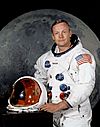 |
Neil Armstrong | Apollo 11 | 2 hours 31 minutes |
| 2 | 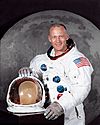 |
Buzz Aldrin | 2 hours 31 minutes | |
| 3 |  |
Pete Conrad | Apollo 12 | 7 hours 45 minutes |
| 4 |  |
Alan Bean | 7 hours 45 minutes | |
| 5 |  |
Alan Shepard | Apollo 14 | 9 hours 22 minutes |
| 6 |  |
Edgar Mitchell | 9 hours 22 minutes | |
| 7 |  |
David Scott | Apollo 15 | 18 hours 34 minutes |
| 8 | 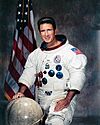 |
James Irwin | 18 hours 34 minutes | |
| 9 | 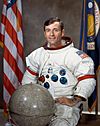 |
John Young | Apollo 16 | 20 hours 14 minutes |
| 10 |  |
Charles Duke | 20 hours 14 minutes | |
| 11 | 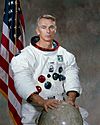 |
Eugene Cernan | Apollo 17 | 22 hours 3 minutes |
| 12 |  |
Harrison Schmitt | 22 hours 3 minutes |
Apollo Astronauts Who Flew to the Moon Without Landing
Besides the 12 people who walked on the Moon, 12 more flew very close to its surface. During each of the six successful Moon landings, one astronaut stayed in orbit while the other two landed. Also, the crews of Apollo 8 and Apollo 10 orbited the Moon, and the crew of Apollo 13 flew around it.
All nine crewed missions to the Moon happened in less than four years, from December 1968 to December 1972. The 24 people who flew to the Moon are the only humans who have traveled beyond low Earth orbit.
Jim Lovell, John Young, and Eugene Cernan are the only three people to have flown to the Moon twice. Young and Cernan landed on their second trips, but Lovell is the only one who flew twice without landing.
Bill Anders on Apollo 8 and Eugene Cernan on Apollo 10 were the youngest people to fly to the Moon (35 years old). Alan Shepard was the oldest person to fly to the Moon (47 years old) on Apollo 14.
The crew of Apollo 13 (Lovell, Swigert, and Haise) flew farther from Earth than any other humans. They reached an amazing distance of 400,171 kilometers (248,655 miles) from Earth!
| Portrait | Name | Mission | Notes | |
|---|---|---|---|---|
| 1 | 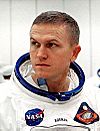 |
Frank Borman | Apollo 8 December 21–27, 1968 |
|
| 2 | 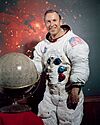 |
Jim Lovell | Apollo 8 December 21–27, 1968 Apollo 13 April 11–17, 1970 |
Intended to land on Apollo 13; only person to fly to the Moon twice without landing. |
| 3 |  |
Bill Anders | Apollo 8 December 21–27, 1968 |
|
| 4 | 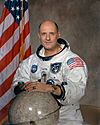 |
Tom Stafford | Apollo 10 May 18–26, 1969 |
Later flew on Apollo–Soyuz Test Project. |
| 5 | 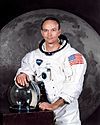 |
Michael Collins | Apollo 11 July 16–24, 1969 |
|
| 6 | 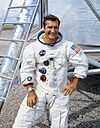 |
Dick Gordon | Apollo 12 November 14–24, 1969 |
Trained to land, slated for Apollo 18 (canceled). |
| 7 |  |
Jack Swigert | Apollo 13 April 11–17, 1970 |
|
| 8 |  |
Fred Haise | Apollo 13 April 11–17, 1970 |
Intended to land; later trained to land and slated to command Apollo 19 (canceled); flew the Space Shuttle on approach / landing tests. |
| 9 | 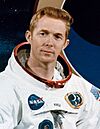 |
Stuart Roosa | Apollo 14 January 31 – February 9, 1971 |
In rotation to land on Apollo 20 (canceled). |
| 10 | 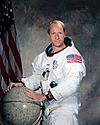 |
Al Worden | Apollo 15 July 26 – August 7, 1971 |
|
| 11 | 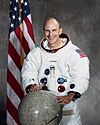 |
Ken Mattingly | Apollo 16 April 16–27, 1972 |
Later flew two Space Shuttle missions. |
| 12 | 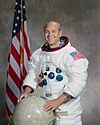 |
Ron Evans | Apollo 17 December 7–19, 1972 |
Lunar Activities
When Neil Armstrong stepped onto the Moon, he said his famous words: "That's one small step for [a] man, one giant leap for mankind." He quickly collected a sample of Moon rocks in case they had to leave quickly. Armstrong then set up a TV camera so people on Earth could watch.
About 19 minutes later, Buzz Aldrin joined Armstrong on the Moon. They had a little trouble planting the American flag, but they got it to stand. Aldrin then tried different ways of moving around on the Moon's surface. While they were doing this, President Nixon called them from Earth to congratulate them!
Aldrin also checked the spacecraft to make sure it was ready for launch. He helped set up some science experiments and hammered a tube into the Moon to get a core sample. Their Moonwalk ended when they loaded the Moon samples back into the spacecraft. Armstrong took most of the photos on the Moon, which is why there are only a few pictures of him there.
After landing the lunar module Falcon, David Scott did a special "stand-up" spacewalk from the top hatch. He used it to look around and plan where he and James Irwin would explore. Scott was the first to drive a vehicle on the Moon, the Lunar Roving Vehicle, which allowed them to explore much more. At the end of their last Moonwalk, Scott showed how objects fall at the same rate in a vacuum by dropping a hammer and a feather for the TV camera.
Irwin joined Scott on the Moon. As the first passenger in the Lunar Roving Vehicle, he had a bumpy ride as Scott drove around craters. Irwin was the one who found the famous Genesis Rock, a piece of the early lunar crust. Irwin was a very religious man and quoted from the Bible while on the Moon. He later became an evangelist.
Apollo Astronauts Who Never Flew to the Moon
Some astronauts flew Apollo missions that stayed in Earth orbit to test the spacecraft. Apollo 7 tested the Command/Service Module, and Apollo 9 tested the Command/Service Module and the Lunar Module. Most of the astronauts on these missions never got to go to the Moon. Also, the three Skylab missions and the Apollo-Soyuz Test Project used Apollo spacecraft in Earth orbit.
- Walter M. Schirra Jr. – Commander of Apollo 7.
- Donn F. Eisele – Command Module Pilot of Apollo 7.
- R. Walter Cunningham – Lunar Module Pilot of Apollo 7.
- James A. McDivitt – Commander of Apollo 9.
- Russell L. "Rusty" Schweickart – Lunar Module Pilot of Apollo 9.
- Joseph P. Kerwin – Science Pilot of Skylab 2.
- Paul J. Weitz – Pilot of Skylab 2.
- Owen K. Garriott – Science Pilot of Skylab 3.
- Jack R. Lousma – Pilot of Skylab 3.
- Gerald P. Carr – Commander of Skylab 4.
- Edward G. Gibson – Science Pilot of Skylab 4.
- William R. Pogue – Pilot of Skylab 4.
- Vance D. Brand – Command Module Pilot of Apollo-Soyuz Test Project.
- Donald K. Slayton – Docking Module Pilot of Apollo-Soyuz Test Project.
Astronauts Who Died During the Apollo Program
Three astronauts died in a fire during a training exercise for the first crewed Apollo mission, Apollo 1.
- Virgil I. "Gus" Grissom (Command Pilot)
- Edward H. White II (Senior Pilot)
- Roger B. Chaffee (Pilot)
See also
- Mercury Seven
- List of Gemini astronauts
- List of Artemis astronauts




